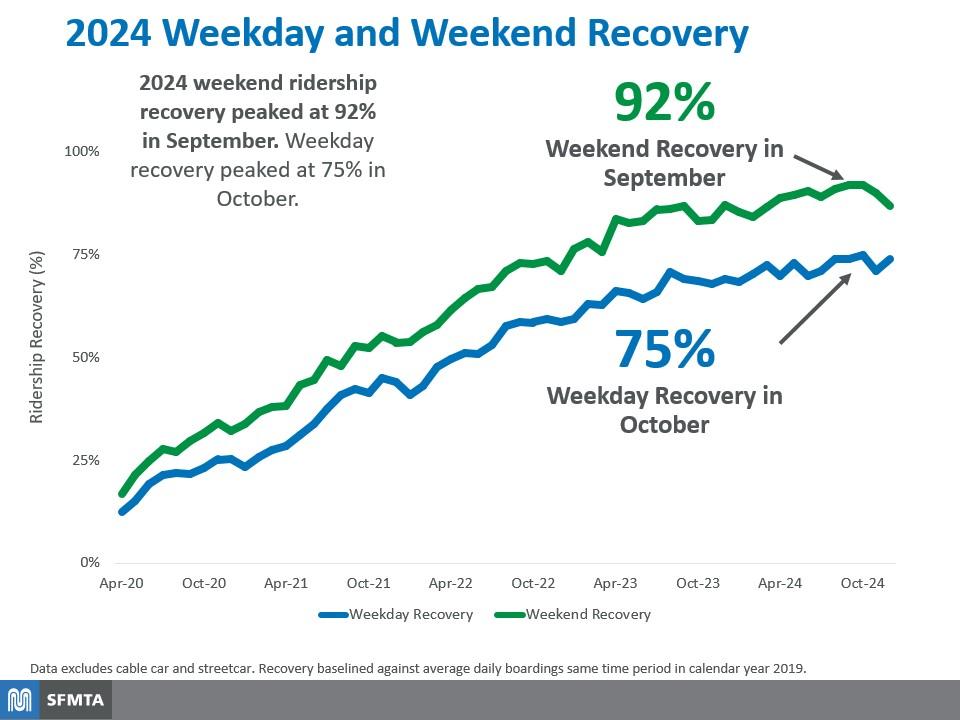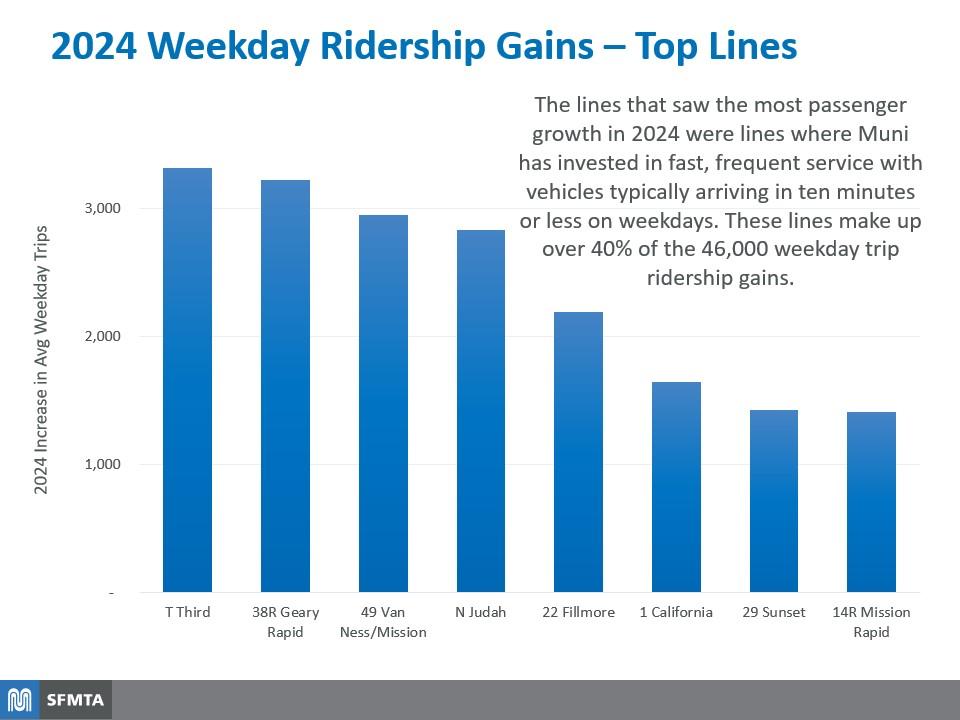
Muni platforms continue to see increased traffic.
Year after year, we’re seeing a strengthened ridership recovery, reaching new highs in 2024, with a total of 158 million passenger trips, resulting in an increase of 13.5 million trips compared to 2023.
The latest data highlights a significant increase in daily boardings and points to several high-performing routes. It also shows the impact of major events on Muni ridership -- people are using Muni more than ever to get to Warriors games, parades and street festivals, and so much more.
Muni is the backbone of San Francisco’s economic vitality.
Ridership grew on weekdays and weekends
In 2024, the SFMTA saw the highest volume of growth in ridership since 2019, with recovery at 75% of 2019 levels and monthly recovery peaking at 78% in September. The city also announced that Muni received the highest customer ratings since 2021.
Last year alone, Muni saw an increase in average boardings on both weekdays and weekends:
- Weekdays:
- 486,000 boardings on average – 46,000 more trips than in 2023
- Ridership recovery peaked in October at 75% of pre-pandemic levels.
- 486,000 boardings on average – 46,000 more trips than in 2023
- Weekends:
- 318,000 boardings on average – 17,000 more trips than in 2023
- Ridership recovery peaked in September at 92% of pre-pandemic levels.
- 318,000 boardings on average – 17,000 more trips than in 2023

Muni moves hundreds of thousands of residents and visitors around the city every day, delivers students to school safely, and workers to their jobs – the continued rise in ridership numbers reflects our ability to provide a reliable and efficient service.
Top-performing Muni routes
Certain routes stand out for their ridership gains, thanks to our investment in fast, frequent and reliable service.
The T Third, 38R Geary Rapid, 49 Van Ness/Mission and N Judah have all seen significant increases in passengers compared to 2019 levels.
With service arrivals every 10 minutes or less, these routes are inspiring more and more people to choose Muni when they travel around San Francisco.

Special events bring more people to Muni
San Francisco’s vibrant events calendar played a key role in boosting ridership. This is proof that public transit is an essential part of the city’s event infrastructure.
- The 7 Haight/Noriega had its highest ridership day of the year on the day of the Sunset Night Market on Aug. 30, 2024.
- The 15 Bayview Hunters Point Express had its highest weekend ridership day of the year on the Saturday of the Portola Music Festival, Sept. 28, 2024.
- The Hardly Strictly Bluegrass Festival saw the 5R Fulton Rapid enjoy its highest ridership day of the year on Oct. 4, 2024, with the 5 Fulton seeing its ridership peak on Oct. 5, 2024.
- On Halloween, ridership surged across Muni, with the 6 Haight/Parnassus, 24 Divisadero, 33 Ashbury/18th Street, 43 Masonic and 49 Van Ness/Mission all recording their highest ridership of the year.
What’s next for Muni?
Major companies such as OpenAI and Databricks are expanding their offices in Mission Bay and downtown. That means thousands of new employees could be commuting via Muni in the coming years.
In February, San Francisco hosted the NBA All Stars and just last week, the NCAA for March Madness games. The city is also preparing to host major events like Super Bowl LX and the 2026 FIFA World Cup. Combined, these events are expected to draw hundreds of thousands of visitors to San Francisco. These developments reinforce the importance of a well-funded and efficient transit system.
Addressing financial challenges
Despite these positive trends, Muni faces significant financial hurdles. The SFMTA faces a deficit of more than $320 million in the budget year that begins in July 2026. Mayor Lurie has appointed new leadership to tackle these fiscal challenges head on, appointing Julie Kirschbaum last month as the new Director of Transportation for the SFMTA. Under Director Kirschbaum’s leadership, Muni has continued to deliver operational improvements throughout the system, including embracing the proactive, preventative maintenance practices that have helped reduce subway delays by 70%.
The city is also taking proactive steps to address these funding challenges. The Muni Funding Working Group, led by the Controller’s Office, is collaborating with city officials, transit leaders and community members to find solutions. State and regional leaders are also working to bridge transit funding gaps. State Senators Scott Wiener and Jesse Arreguín are advancing a regional effort to secure long-term transit funding.
Commitment to a sustainable future
As Muni continues to recover and ridership grows, we remain committed to delivering safe, reliable and accessible transit for all. As financial challenges persist, we’re working on efficiency plans that minimize service cuts while protecting key transit connections. Sustainable funding solutions and advocacy at the state and regional levels will be crucial. They will help ensure that Muni remains the best transportation option for San Franciscans.
Comments are for the English version of this page.